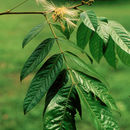Habitat
(
Spanish; Castilian
)
provided by INBio
Se observa en áreas abiertas, caminos, borde de bosques, ríos, vegetación secundaria , vegetación costera
">http://darnis.inbio.ac.cr/FMPro?-db=imagenes.fp3&key=38743&-img"> (Ver fotografía) , así como manglares. En climas húmedos a muy húmedos, con estación seca marcada. Tanto en la costa pacífica como en la atlántica la especie regenera y crece bien en suelo arenoso, por lo que es ideal para embellecer y arbolar la línea costera.
- author
- Nelson Zamora
- editor
- Mery Ocampo
Distribution
(
Spanish; Castilian
)
provided by INBio
Distribucion en Costa Rica: Parte noreste de la vertiente atlántica y parte suroeste de la vertiente pacífica. Elevación 0-600 m.
Distribucion General: Desde México hasta Venezuela y Ecuador.
- author
- Nelson Zamora
- editor
- Mery Ocampo
Diagnostic Description
(
Spanish; Castilian
)
provided by INBio
Árbol de 5 a 15 m de altura; ramitas densamente ferrugíneo-tomentosas y lenticeladas ; estípulas hasta 3 mm de largo, decíduas. Hojas con (5-)7-10 (-13) pares de folíolos, oblongos a lanceolados, ápice redondeado, obtuso o acuminado, ferrugíneo-pubescentes en el envés, el par distal de 7-14 por 3-5 cm, par basal de 2.5-9 por 1.5 -4.5 cm; raquis cilíndrico o en ocasiones ligeramente alado distalmente, glándulas interfoliolares sésiles
http://darnis.inbio.ac.cr/FMPro?-db=imagenes.fp3&key=38744&-img" > (Ver fotografía) ; pecíolo cilíndrico. Inflorescencias espigas, pedúnculo de 1.5-5.5 cm de largo, raquis floral de 1.5-2 cm de largo. Flores cáliz de 7-10 mm de largo; corola de 12-25 mm de largo
http://darnis.inbio.ac.cr/FMPro?-db=imagenes.fp3&key=38741&-img" > (Ver fotografía) . Frutos aplanados o subcilíndricos de 15 -19 por 1.5-3 cm, pardo-rojizos y lustrosos
">http://darnis.inbio.ac.cr/FMPro?-db=imagenes.fp3&key=38742&-img"> (ver fotografía) . Normalmente confundida con
I. thibaudiana http://guest:guest@darnis.inbio.ac.cr/FMPro?-DB=UBI&-lay=WebAll&-Format=/ubi/detail.html&-Op=bw&id=623&-Find =" > (Ver descripción), pero difiere de ella por su cáliz más largo y mayor número de folíolos, con una pubescencia de pelos curvos.
I. aestuariorum se considera solo como subespecie y se caracteriza por tener menor número de folíolos y flores relativamente más cortas. Además, se distribuye en zonas costeras, incluidos los manglares. Nota: Ver estructuras ilustradas en:
http://darnis.inbio.ac.cr/FMPro?-db=imagenes2.fp3&key=34521&-img" > (Glosario 1) y
http://darnis.inbio.ac.cr/FMPro?-db=imagenes2.fp3&key=34522&-img" > (Glosario 2).
- author
- Nelson Zamora
- editor
- Mery Ocampo
Benefits
(
Spanish; Castilian
)
provided by INBio
Para leña y sombra, en sitios costeros.
- author
- Nelson Zamora
- editor
- Mery Ocampo
Diagnostic Description
(
Spanish; Castilian
)
provided by INBio
Localidad del tipo: Panamá, Zona del Canal.
Depositario del tipo: K
Recolector del tipo: Sutton Hayes (645)
- author
- Nelson Zamora
- editor
- Mery Ocampo
Comprehensive Description
provided by North American Flora
Inga multijuga Benth. Trans. Linn. Soc. 30: 615. 1875
Feuilleea multijuga Kuntze, Rev. Gen. PI. 188. 1891.
A tree, 3-13 m. high, the young branches brownish-tomentose. Rachis of leaf wingless, 2-3 dm. long, pubescent, with large cup-shaped glands between each pair of leaflets; leaflets 5 to 10 pairs, oblong to lanceolate, 4—15 cm. long, acute, or sometimes long-acuminate, glabrate and shining above, reticulate, pale and pubescent beneath; peduncles axillary, sometimes in pairs, 2-3 cm. long, pubescent; spikes 1.5 cm. long or less; calyx 7-8 mm. long, striate, pubescent; corolla about 25 mm. long, appressedvillous; stamen-sheath shorter than the corolla.
Type locality: Panama. Distribution : Panama and Guatemala.
- bibliographic citation
- Nathaniel Lord Britton and Joseph Nelson Rose. 1928. (ROSALES); MIMOSACEAE. North American flora. vol 23(1). New York Botanical Garden, New York, NY
Inga multijuga: Brief Summary
(
German
)
provided by wikipedia DE
Inga multijuga ist eine Baumart aus der Unterfamilie der Mimosengewächse (Mimosoideae). Sie ist in Mittel- und Südamerika beheimatet.
- license
- cc-by-sa-3.0
- copyright
- Autoren und Herausgeber von Wikipedia
Inga multijuga: Brief Summary
(
Vietnamese
)
provided by wikipedia VI
Inga multijuga là một loài thực vật có hoa trong họ Đậu. Loài này được Benth. miêu tả khoa học đầu tiên.
- license
- cc-by-sa-3.0
- copyright
- Wikipedia tác giả và biên tập viên

